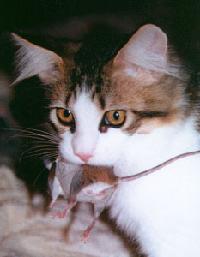|
When Maine Coon Cats Had Jobs
|
 |
| Furkats Alexander, brown tabby & white Maine Coon Cat Poly with a real mouse |
|
|
|
When They Had Jobs! Historical References to Maine Coons Cats at Work
The following statements about Maine Coon Cats were taken from articles in local newspapers and magazines. They were found in published documents from in or near the State of Maine. These quotes support the notion that the Maine Coon Cat was a long established working breed of cats. These selections further make it clear that the Maine Coon Cats were respected for their strength, character and ability to survive in the harsh New England climate by hunting for rodents and other small prey.
According to Jeff Clark who wrote in Dec, 1994 in Down East Magazine stated that indeed, old timers who once gave away coon cat kittens to any passing tourist who asked for one, would be more than a little chagrined to lean that the Maine Coon cats are now worth staggering sums. He goes on to note the Maine coon cat's sudden and wide spread popularity isn't an entirely new phenomenon. Maine Coons dominated the professional American cat-show circuit in the late nineteenth century before their plebeian origins saw them banished in favor of more exotic varieties. After all, why should a chichi Persian that could trace its bloodline back to the Crusades have to compete against a feisty barn cat of uncertain ancestry with a taste for fresh-caught rat. Appearing in Down East Magazine, October of 1978, Mimi E. B. Steadman wrote, when October winds grow brisk, some house cats retreat to a favorite corner by the kitchen cook stove. Not so the native Maine Coon Cat. This hardy breed is dressed for the weather in long shaggy hair and a dense undercoat perfectly adapted to slough off heavy snow and seal out the cold. In conditions that would send a shivering short-haired cat back to the hearth, Maine Coons can range far a field, their oversized tufted paws-sometimes endowed with extra toes allowing them to snowshoe through frozen woods, and their heavy boned frames ideally suited to bushwhacking in rugged terrain.
The long rectangular body profile, as opposed to the Persian's square build, enables these cats to wind their way over and around heavy undergrowth and fallen trees with an agile speed that has insured their survival for some two hundred years. In other article by Mimi E. B. Steadman called "You Can Tell New Englanders By The Cats They Keep". The author noted that because double-pawed or polydactyl, cats have been a New England favorite for almost 300 years, one can trace the last three centuries migration of region residents by keeping an eye out for these large-footed felines. This article notes that Dr. Neil B Todd, adjunct professor at Boston University's Department of Biology has spend several years tallying the occurrence of extra-toed or polydactyl cats in New England . This genetic mutation, giving the cats the appearance of having double paws, is far more common among Northeastern felines than among cats anywhere else in the world. In fact, Todd's survey of Boston cats have shown that as many as eight out of every ten exhibit some degree of polydactylism, while polydactyls occurs in less than one percent of cat populations else where. A dominant genetic trait that Todd estimates originated around 1680 within 50 miles of Boston , polydactylism can be used to trace the migration of New Englanders into Canada during the American Revolution. At that time families from the 13 Colonies who were unsympathetic to the rebel cause moved north to the Maritime Provinces . New Englanders packed up their belongings including their cats and headed to Nova Scotia and New Brunswick (Canada), while Colonists from the Mid-Atlantic area settled on Newfoundland and Prince Edward Island. The survey found many more polydactyl cats in Halifax and Nova Scotia area. The article also noted that their socio-scientific significance, these mittened kittens have won the affection of many New Englanders who consider them lucky and are intrigued by their oversized feet.
article continues on Jobs For Maine Coons part 2
|
|
|